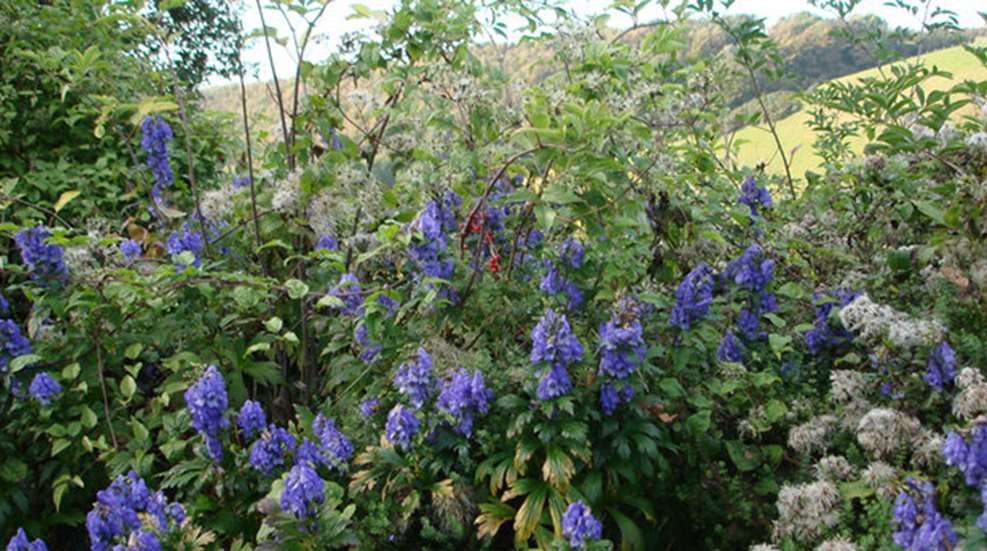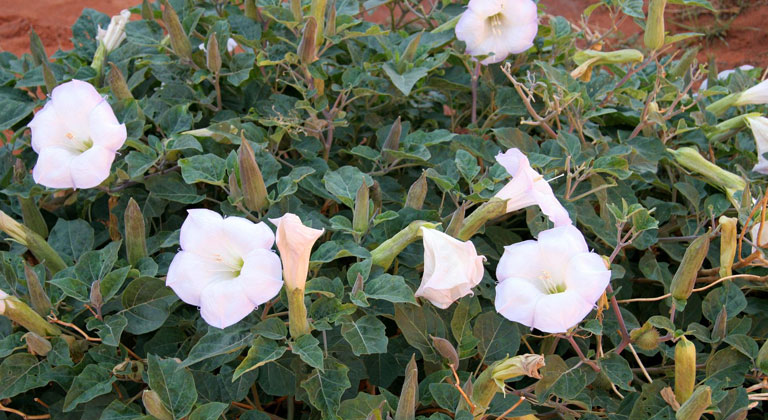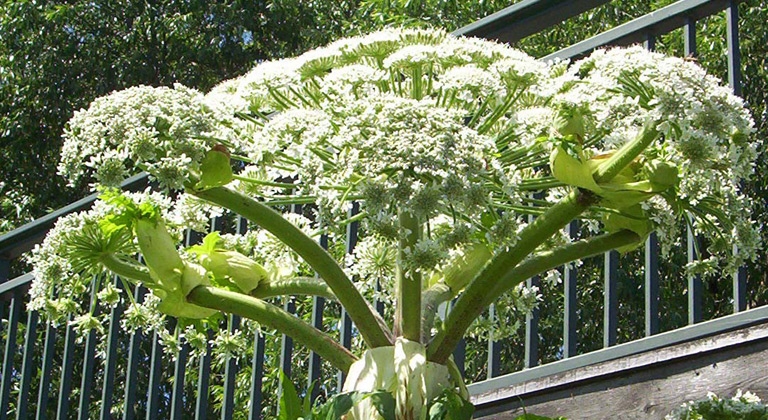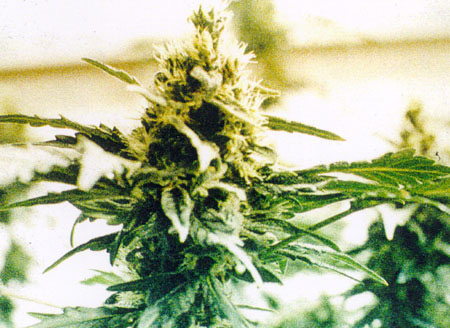
Finally, it's officially summertime, and you know what that means: Hiking, camping, swimming, scouting, varmint hunting, fishing and just about everything outdoors. The vast majority of the time you spend out there will be fun and safe (as long as you observe some basic precautions), but every now and then it's possible your adventures might put you in the vicinity of something dangerous. When you think outdoor dangers, you probably think along the lines of flash floods, sudden storms or ornery critters. Chances are you probably don't think at all about the plant kingdom, and if you do, you're probably thinking of poison ivy, poison oak or poison sumac. Something that yes, might give you an annoying rash, but is more or less just "one of those things" that those who love the outdoors encounter from time to time. However, it's a good idea to remember that even plants are (to quote Dr. Ellie Sattler in the original Jurassic Park movie) "aggressive living things that...will defend themselves. Violently, if necessary." Turns out, there are plenty of ordinary-looking, even beautiful, plants growing wild that you should cut a nice, wide berth—and poison ivy didn't even make the list.
1. Aconite (pictured above, image by Tom Joliffe)
First up, a gorgeous purple flower known colloquially as monkshood. If you don't recognize that name, you might recognize it by some of its more ominous sobriquets: Wolf's bane, devil's helmet or queen of poisons. (Yikes.) It's a hardy plant and can be found growing in the wild all over North America, in part because it is cultivated in gardens as an ornamental plant. This is despite the fact that wolf's bane has been a known poison for pretty much all of recorded human history; references to it can be found in Greek mythology, 13th-century Japanese drama and the works of Shakespeare. It's been widely used as an arrow poison for hunting large game by various cultures, such as the Japanese Ainu and the Chinese. Of particular note is that it's not necessary to actually ingest any part of the aconite plant in order to be poisoned; it's possible to absorb the poison through the skin simply by picking the plant without gloves (which resulted in a tragic death two years ago), and this is definitely a bloom that's pretty enough to inspire an uninformed person to gather a bouquet to take home. The plant's toxicity can be treated medically if sufferers seek prompt assistance...and here's where things get interesting. One of the medications that doctors will use to counteract the effects of aconite poisoning is, get this, atropine. Which is derived from:

2. Datura
Datura stramonium, which is a member of the nightshade family, is another very attractive and very hardy blooming plant that is both cultivated for decorative purposes and found in the wild all over North America. Also known as jimsonweed, devil's snare, devil's trumpet and hell's bells, the names alone should give you pause. Unlike wolf's bane, which is more or less universally known as poisonous, there are some native cultures that use this plant and its relatives in the nightshade family for ceremonial purposes. The problem is that the same chemicals that can induce a "vision quest" can also cause toxicity and death, and it's virtually impossible to know just how concentrated any individual plant's toxins are. Each year, a few people—usually teens—get the not-so-bright idea to deliberately ingest datura...and sadly, some of them pay for this mistake with their lives. Although there are legitimate medical uses for the chemicals that can be derived from this plant, it's best to leave their formulation and administration to medical professionals. The good news is that it's tough to accidentally wind up on the wrong side of datura, unlike:

3. Giant Hogweed
Despite its name, this enormous tree-like plant is actually quite attractive—although the "giant" part is certainly no misnomer. It can get to 14 feet tall, and sports enormous, 5-foot-wide palm-like lives. When in bloom, it looks like nothing so much as a mega-sized Queen Anne's Lace flower. Originating in Asia, this invasive species made its way to American shores as a decorative planting, and now it's growing wild in various parts of America and Canada. Doesn't sound so bad, right? Wrong...this plant is not just highly toxic when ingested, its poison can harm you from a simple touch. And unlike poison ivy, you won't just get a rash. The sap of giant hogweed, which you can get on your skin from plucking the leaves or just brushing against the bristles on the stem, causes serious blistering and burning that gets exponentially worse when exposed to sunlight. People have been blinded by getting just a tiny quantity in their eyes. The potential danger of this plant is such that the Department of Environmental Conservation in New York State (which is currently experiencing an epidemic of giant hogweed) warns folks who find one to not even go near it. Instead, the DEC asks people to contact them directly to have the plants professionally removed. So yes, giant hogweed is pretty scary.
But what plant, encountered in the woods on a casual hike, is the one that should have you turning tail and running as quickly as you can in the opposite direction? That honor probably belongs to:

4. Cannabis
OK, we get it—you're probably scratching your head right now. We'll explain. But first, it's important to note that the NRA does not have a position on any of the controversies surrounding this particular horticultural specimen. It's also important to note that although there's room for debate as to the relative harmfulness of this plant, it's not, strictly speaking, considered poisonous. So why should you run like your shoes are on fire and your shirttail is catching if you see a bunch of it out in nature? Well, although many states have either legalized or decriminalized the possession of this plant, it's still quite illegal in many others. This means that if you find it growing in the wild, it's very possible that it was deliberately planted there...and whoever did the planting is probably a criminal. Said criminal or criminals may not be very far away, as it's fairly common for them to set guards on their illicit crops. If they're there, those guards are probably not playing by Marquis of Queensbury rules. Your best bet is to put as much distance in between you and your discovery as you can, as quickly and as quietly as you can. You can always contact the authorities later.
Have you ever run across any of the above in your time in the outdoors? Tell us in the comments!
1. Aconite (pictured above, image by Tom Joliffe)
First up, a gorgeous purple flower known colloquially as monkshood. If you don't recognize that name, you might recognize it by some of its more ominous sobriquets: Wolf's bane, devil's helmet or queen of poisons. (Yikes.) It's a hardy plant and can be found growing in the wild all over North America, in part because it is cultivated in gardens as an ornamental plant. This is despite the fact that wolf's bane has been a known poison for pretty much all of recorded human history; references to it can be found in Greek mythology, 13th-century Japanese drama and the works of Shakespeare. It's been widely used as an arrow poison for hunting large game by various cultures, such as the Japanese Ainu and the Chinese. Of particular note is that it's not necessary to actually ingest any part of the aconite plant in order to be poisoned; it's possible to absorb the poison through the skin simply by picking the plant without gloves (which resulted in a tragic death two years ago), and this is definitely a bloom that's pretty enough to inspire an uninformed person to gather a bouquet to take home. The plant's toxicity can be treated medically if sufferers seek prompt assistance...and here's where things get interesting. One of the medications that doctors will use to counteract the effects of aconite poisoning is, get this, atropine. Which is derived from:

2. Datura
Datura stramonium, which is a member of the nightshade family, is another very attractive and very hardy blooming plant that is both cultivated for decorative purposes and found in the wild all over North America. Also known as jimsonweed, devil's snare, devil's trumpet and hell's bells, the names alone should give you pause. Unlike wolf's bane, which is more or less universally known as poisonous, there are some native cultures that use this plant and its relatives in the nightshade family for ceremonial purposes. The problem is that the same chemicals that can induce a "vision quest" can also cause toxicity and death, and it's virtually impossible to know just how concentrated any individual plant's toxins are. Each year, a few people—usually teens—get the not-so-bright idea to deliberately ingest datura...and sadly, some of them pay for this mistake with their lives. Although there are legitimate medical uses for the chemicals that can be derived from this plant, it's best to leave their formulation and administration to medical professionals. The good news is that it's tough to accidentally wind up on the wrong side of datura, unlike:

3. Giant Hogweed
Despite its name, this enormous tree-like plant is actually quite attractive—although the "giant" part is certainly no misnomer. It can get to 14 feet tall, and sports enormous, 5-foot-wide palm-like lives. When in bloom, it looks like nothing so much as a mega-sized Queen Anne's Lace flower. Originating in Asia, this invasive species made its way to American shores as a decorative planting, and now it's growing wild in various parts of America and Canada. Doesn't sound so bad, right? Wrong...this plant is not just highly toxic when ingested, its poison can harm you from a simple touch. And unlike poison ivy, you won't just get a rash. The sap of giant hogweed, which you can get on your skin from plucking the leaves or just brushing against the bristles on the stem, causes serious blistering and burning that gets exponentially worse when exposed to sunlight. People have been blinded by getting just a tiny quantity in their eyes. The potential danger of this plant is such that the Department of Environmental Conservation in New York State (which is currently experiencing an epidemic of giant hogweed) warns folks who find one to not even go near it. Instead, the DEC asks people to contact them directly to have the plants professionally removed. So yes, giant hogweed is pretty scary.
But what plant, encountered in the woods on a casual hike, is the one that should have you turning tail and running as quickly as you can in the opposite direction? That honor probably belongs to:

4. Cannabis
OK, we get it—you're probably scratching your head right now. We'll explain. But first, it's important to note that the NRA does not have a position on any of the controversies surrounding this particular horticultural specimen. It's also important to note that although there's room for debate as to the relative harmfulness of this plant, it's not, strictly speaking, considered poisonous. So why should you run like your shoes are on fire and your shirttail is catching if you see a bunch of it out in nature? Well, although many states have either legalized or decriminalized the possession of this plant, it's still quite illegal in many others. This means that if you find it growing in the wild, it's very possible that it was deliberately planted there...and whoever did the planting is probably a criminal. Said criminal or criminals may not be very far away, as it's fairly common for them to set guards on their illicit crops. If they're there, those guards are probably not playing by Marquis of Queensbury rules. Your best bet is to put as much distance in between you and your discovery as you can, as quickly and as quietly as you can. You can always contact the authorities later.
Have you ever run across any of the above in your time in the outdoors? Tell us in the comments!




































